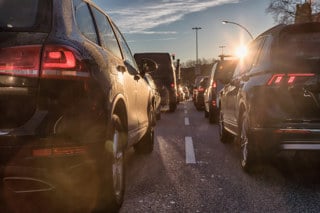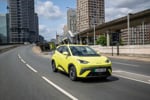The number of vehicles using UK roads has almost returned to normal, following the relaxation of Coronavirus lockdown rules.
Daily lorry traffic has been at 90% or above of what it was pre-lockdown, since July 6 while daily van traffic has peaked at 94% of its usual level.
Overall, weekday traffic levels have reached a peak of 86% (on July 10) of those recorded before the March 23 lockdown began.
The data, published by the Department of Transport, highlights the changing attitudes of commuters and travellers in a post-Covid world.
Public transport usage remains at less than a third of its usual level, as people continue to socially distance and work from home.
Car usage, meanwhile, has consistently been at 70% of its usual level since June 15, despite a significant reduction in commuting and business travel – suggesting that the public is simply avoiding public transport and opting to drive.
Rail travel has reached a daily high of just 18% of expected levels, while the London Underground is only seeing around19% of its usual footfall.
Steve Gooding, director of the RAC Foundation, said: “In terms of lorry traffic it’s almost as if Coronavirus didn’t happen, with volumes staying close to pre-lockdown levels throughout. What’s interesting is the extent to which van traffic has come back, which could be good news for the economy and for congestion if those vans aren’t heading into town in the rush hour but are instead making home deliveries throughout the day and into the evening.
“The fact that car traffic is back to four fifths of what it was before the lockdown shouldn’t surprise us, given the Government’s ongoing advice to avoid public transport, but since the Government is also advising us to work from home if we can it begs the question of what these car trips are about and how different they are to our traditional commuting patterns.”
Cycle use has boomed since the Coronavirus outbreak, consistently above 100% of normal levels.
INRIX studied the vehicle-miles travelled (VMT) across Europe during the pandemic and found that in the UK specifically, VMT fell by 56% during the week of March 23 alone.
It stagnated for about a month, then began to rise throughout May and June with the reopening of recreational sites and retail locations. Notably, weekend travel remains strong across the UK.
The effects of reduced VMT are reflected in lower travel times and faster vehicle speeds across the UK. By June, drivers around Edinburgh saw the largest speed increases out of all cities studied, with a 69% jump in speed during the 8:00AM rush hour, while drivers in Belfast during the afternoon commute saw a 12% increase in travel speeds.
However, as VMT continues to grow, travel speeds have started to retract. Speeds around London have fallen from their April highs significantly (when VMT was at its lowest point), dropping 26% in the AM commute and 36% in the PM commute. Despite the drops in speeds, however, rush hour travel is still more than 20% faster in June than it was in February.
As cities continue to rebound from Covid-related lockdowns, traffic congestion will continue to rise, says INRIX. However, it believes that the intensity of congestion may not reach ‘normal’ levels for a while if telecommuting habits, the prevalence of online shopping and public transport and cycling use change.























Login to comment
Comments
No comments have been made yet.